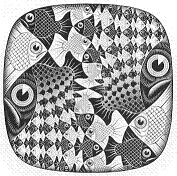What is Poetry, Part II --
Gombrich vs. Gadamer
Excerpts from
Tetsuhiro Kato on
Gombrich and the
Hermeneutics of Art
Kato on Gombrich
"... according to Gombrich, an image is susceptible to become a target for 'symbol detectives'.... But the hidden authorial intention... ([for example]... astrology, recalling the famous warning of Panofsky [1955: 32]), almost always tends to become a reproduction of the interpreter's own ideological prejudice. Not to give into the irrationalism such psychological overinterpretation might invite.... we have to look for the origin of meaning... in... the social context.... The event of image making is not the faithful transcription of the outside world by an innocent eye, but it is the result of the artist's act of selecting the 'nearest equivalence'... based on social convention...."
Kato on Gadamer
"For [Gadamer], picture reading is a process where a beholder encounters a picture as addressing him or her with a kind of personal question, and the understanding develops in the form of its answer (Gadamer 1981: 23-24; Gadamer 1985: 97,102-103). But, it must be noted that by this Gadamer does not mean to identify the understanding of an image with some sort of 'subsumption' of the image into its meaning (Gadamer 1985: 100). He insists rather that we can understand an image only by actualizing what is implied in the work, and engage in a dialogue with it. This process is ideally repeated again and again, and implies different relations than the original conditions that gave birth to the work in the beginning (Gadamer 1985: 100).
What matters here for Gadamer is to let the aesthetic aspect of image take its own 'Zeitgestalt' (Gadamer 1985: 101)."
Example (?) -- the Zeitgestalt
of today's previous entry:

See, too,
The Quality of Diamond.
Kato's References:
Gadamer, Hans-Georg. 1981. "Philosophie und Literatur: Was ist die Literatur?," Phänomenologische Forschungen 11 (1981): 18-45.
Gadamer, Hans-Georg. 1985. "Über das Lesen von Bauten und Bildern." Modernität und Tradition: Festschrift für Max Imdahl zum 60. Geburtstag. Ed. Gottfried Boehm, Karlheinz Stierle, Gundorf Winter. Munchen: Wilhelm Fink. 97-103.
Panofsky, Erwin. 1955. Meaning in the Visual Arts: Papers in and on Art History. New York: Anchor.








Recent Comments